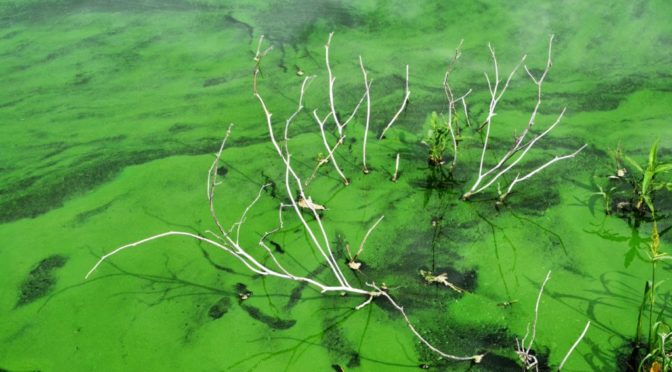
TOPEKA – Officials with the Kansas Departments of Wildlife, Parks, and Tourism (KDWPT) and Health and Environment (KDHE) want dog owners to be aware how dangerous harmful algae blooms (HABs) can be to their dogs.
A HAB is an abnormally high population of blue-green algae in a body of water. Whether you hunt with your dog near water or just take it out for a walk, there are things you can do to protect your four-legged partner.
HABs can occur in lakes, ponds, wetlands, creeks or drainage areas, generally coinciding with warm water temperatures and often flourishing in nutrient-laden waters.
Dogs can become seriously ill or die if they swim in, drink or retrieve a bird from water affected by a HAB.
They can even be sickened if they lick their fur after exposure or eat dried algae along the shore or floating in the water.
A HAB may look like foam, scum or paint floating on the water and be colored blue, bright green, brown or red.
There may also be a very strong musty odor or the smell of sewage or petroleum.
This season, if the water appears or smells suspicious or if there are decaying algae on the shore, do not let your furry friend drink, swim or retrieve birds in the water.
Blue-green algae are really a type of bacteria called “cyanobacteria,” which occurs naturally in all waters around the globe.
Under the right conditions, the algae can rapidly increase (bloom) and produce toxins. Although HABs typically begin in May, they can occur through October or later.
Algae can wash up on shorelines and in marshy areas and even after they are dead and dry, toxins that were produced can persist for long periods.
Dogs will still be at risk if they drink the HAB-affected water, walk on, roll in, eat decaying algae along the shore or retrieve a bird with algae on its feathers.
Just a small amount of blue-green algae can sicken or kill a dog.
The signs of illness in dogs usually occur within 30 minutes of exposure and include vomiting, diarrhea, lethargy, convulsions, difficulty breathing and general weakness.
If you suspect your dog has ingested algae or has any of these symptoms, contact your veterinarian immediately.
People may also become ill after contact with algae-produced toxins. Symptoms vary, depending upon the type of exposure (e.g. direct contact, ingestion, inhalation) but can include rash, vomiting, diarrhea, fever, sore throat, and headache.
If you or your dog come into contact with algae, immediately rinse the contact area with clean, fresh water. If you or your dog show signs of illness, call your physician or veterinarian.
KDWPT and KDHE offer the following tips to help prevent HAB poisoning in dogs:
· Carry potable water for yourself and your dog when hunting or going for walks along the shore.
· Train dogs to come to you for a drink of water.
· Rinse off your dog with potable water as quickly as possible if your dog swims in a HAB or walks through dried algae.
· Do not let dogs eat dried algae along the shoreline. A bluish color along the shore indicates dying, toxic blue-green algae.
· Do not let your dog lick their paws if they have walked through dried algae and remember that waterfowl in HAB-affected water may have toxic cells on their feathers.
KDHE samples publicly-accessible bodies of water for blue-green algae when the agency is alerted to a potential HAB.
When a HAB occurs, KDHE, in cooperation with KDWPT and other lake managers where appropriate, responds by informing the public of these conditions.
KDHE does not sample private bodies of water such as farm ponds or livestock watering tanks but has recommendations on what to look for, how to field test and who to contact for additional assistance on KDHE’s HAB website.
For the most up-to-date list of waters currently affected by HABs, or to report a suspected HAB not currently listed, visit www.kdheks.gov/algae-illness. Hunters and the public can also get current HAB-related lake conditions by calling 1-855-HAB-LAKE (1-855-422-5253).
